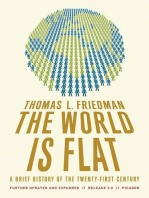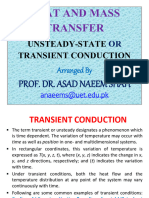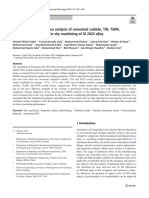0 ratings0% found this document useful (0 votes)
14 viewsCamScanner 10-26-2023 09.00
CamScanner 10-26-2023 09.00
Uploaded by
Iyan MehmoodCopyright:
© All Rights Reserved
Available Formats
Download as PDF or read online from Scribd
CamScanner 10-26-2023 09.00
CamScanner 10-26-2023 09.00
Uploaded by
Iyan Mehmood0 ratings0% found this document useful (0 votes)
14 views7 pagesCopyright
© © All Rights Reserved
Available Formats
PDF or read online from Scribd
Share this document
Did you find this document useful?
Is this content inappropriate?
Copyright:
© All Rights Reserved
Available Formats
Download as PDF or read online from Scribd
Download as pdf
0 ratings0% found this document useful (0 votes)
14 views7 pagesCamScanner 10-26-2023 09.00
CamScanner 10-26-2023 09.00
Uploaded by
Iyan MehmoodCopyright:
© All Rights Reserved
Available Formats
Download as PDF or read online from Scribd
Download as pdf
You are on page 1of 7
Heat and Mass Transfer
- [Cy—4— Gps} and A
(Qny
Hence, Nu=
194) is that asa first approximation, the temperature profi.
by Eqs. (4.186) and (4.187) for T, and T,, are used
substitute (T,— T)/(T,- T,,) in Eq. (4.194), then integration is carried to find a new profile for 7 ang
then T,, The new equations are then again substituted in Eq, (4.194) to find another profile for
and then obtain T,, as done in case of the constant heat flux. The repeated integration will give the
values of Nu, which will converge to a limit. This will be Nu = 3.657.
Let us now do this exercise to get the value of Nusselt number for the case of constant surface
) for T, and T,, we get
‘The alternative method of solving Eq. (4
for the constant heat flux condition given
temperature. Thus, from Eqs. (4.186) and (4.1
ee Le
4 16r,
13( ot).
rar” ar)
3(-2)- 48u,,
or art ar) Nar?
Integration will lead to (2
r
Again integration will give
The boundary conditions (9T/ar) = 0 at r= 0 will give C, =O and T-
ee
Convective Heat Transfer wl
a
212ml (its6t5 3-4-2)
lo Smeea4 9° 64 16) dy * 2
251 fe Um AT,
“48 Ha dx
fare rn
ieee 4a" ct at
24x6r 16 6x6r? 32x68,
paneer! age
E hap (4.199)
4 64r5 16 12 48) dx
Fi ,
Jutrar and wath fev get
z
7 251m Sr®
‘16 12 48 36r,
asin
12 48
——
ar ate Be 4 BE 19r_saae ee ee
yy) a 59 \ 48r2 24078 * 4 ae made 5\% +
32r) d r
agin integration will give
uy 20 (_ 83r_ | 897"? 4 19r° 683"? 251rer!
50 | 3847? 24007) 24. S384’ S96 +Clnr+C,
(4.205)
eee oT
Theboundary conditions =-=0 at r=0 will give C, =0, and T= 7, at r=r, will give
4627u,,1) AT, 2
BC, or C= 7, tn’ Oly
"94400, dx 94400 dx
ires will become
m+,
dx
(4.206)
_83r_897"° lor, 251rn) r?_ 683r'r; _ 462718 dT,
96r; 600r' 6 24 96r° 96 800
e
=— 2, furrar and wmf!
_ 831"
96r? — 600r;
19r°
+
2sir'rs or 683r'n
83r ce
~ 96r 24 (Gr 96
1s
4u, 5 || 4627r Bar _ bor! _lor _ 251 a aT a,
roa 59 J}- Boo 96k, 600K. 6 | 2A BE | Ox
6837’, 4627r' mn)
sa * 300
You might also like
- The Subtle Art of Not Giving a F*ck: A Counterintuitive Approach to Living a Good LifeFrom EverandThe Subtle Art of Not Giving a F*ck: A Counterintuitive Approach to Living a Good LifeRating: 4 out of 5 stars4/5 (5981)
- The Gifts of Imperfection: Let Go of Who You Think You're Supposed to Be and Embrace Who You AreFrom EverandThe Gifts of Imperfection: Let Go of Who You Think You're Supposed to Be and Embrace Who You AreRating: 4 out of 5 stars4/5 (1112)
- Never Split the Difference: Negotiating As If Your Life Depended On ItFrom EverandNever Split the Difference: Negotiating As If Your Life Depended On ItRating: 4.5 out of 5 stars4.5/5 (898)
- Grit: The Power of Passion and PerseveranceFrom EverandGrit: The Power of Passion and PerseveranceRating: 4 out of 5 stars4/5 (619)
- Hidden Figures: The American Dream and the Untold Story of the Black Women Mathematicians Who Helped Win the Space RaceFrom EverandHidden Figures: The American Dream and the Untold Story of the Black Women Mathematicians Who Helped Win the Space RaceRating: 4 out of 5 stars4/5 (932)
- Shoe Dog: A Memoir by the Creator of NikeFrom EverandShoe Dog: A Memoir by the Creator of NikeRating: 4.5 out of 5 stars4.5/5 (546)
- The Hard Thing About Hard Things: Building a Business When There Are No Easy AnswersFrom EverandThe Hard Thing About Hard Things: Building a Business When There Are No Easy AnswersRating: 4.5 out of 5 stars4.5/5 (356)
- Her Body and Other Parties: StoriesFrom EverandHer Body and Other Parties: StoriesRating: 4 out of 5 stars4/5 (831)
- Elon Musk: Tesla, SpaceX, and the Quest for a Fantastic FutureFrom EverandElon Musk: Tesla, SpaceX, and the Quest for a Fantastic FutureRating: 4.5 out of 5 stars4.5/5 (476)
- The Emperor of All Maladies: A Biography of CancerFrom EverandThe Emperor of All Maladies: A Biography of CancerRating: 4.5 out of 5 stars4.5/5 (275)
- The Little Book of Hygge: Danish Secrets to Happy LivingFrom EverandThe Little Book of Hygge: Danish Secrets to Happy LivingRating: 3.5 out of 5 stars3.5/5 (424)
- The World Is Flat 3.0: A Brief History of the Twenty-first CenturyFrom EverandThe World Is Flat 3.0: A Brief History of the Twenty-first CenturyRating: 3.5 out of 5 stars3.5/5 (2272)
- The Yellow House: A Memoir (2019 National Book Award Winner)From EverandThe Yellow House: A Memoir (2019 National Book Award Winner)Rating: 4 out of 5 stars4/5 (99)
- Devil in the Grove: Thurgood Marshall, the Groveland Boys, and the Dawn of a New AmericaFrom EverandDevil in the Grove: Thurgood Marshall, the Groveland Boys, and the Dawn of a New AmericaRating: 4.5 out of 5 stars4.5/5 (270)
- The Sympathizer: A Novel (Pulitzer Prize for Fiction)From EverandThe Sympathizer: A Novel (Pulitzer Prize for Fiction)Rating: 4.5 out of 5 stars4.5/5 (125)
- Team of Rivals: The Political Genius of Abraham LincolnFrom EverandTeam of Rivals: The Political Genius of Abraham LincolnRating: 4.5 out of 5 stars4.5/5 (235)
- A Heartbreaking Work Of Staggering Genius: A Memoir Based on a True StoryFrom EverandA Heartbreaking Work Of Staggering Genius: A Memoir Based on a True StoryRating: 3.5 out of 5 stars3.5/5 (232)
- On Fire: The (Burning) Case for a Green New DealFrom EverandOn Fire: The (Burning) Case for a Green New DealRating: 4 out of 5 stars4/5 (75)
- The Unwinding: An Inner History of the New AmericaFrom EverandThe Unwinding: An Inner History of the New AmericaRating: 4 out of 5 stars4/5 (45)
- HMT HT1 Lab ManualDocument16 pagesHMT HT1 Lab ManualIyan MehmoodNo ratings yet
- HMT Week 5Document21 pagesHMT Week 5Iyan MehmoodNo ratings yet
- HMT Week 6Document28 pagesHMT Week 6Iyan MehmoodNo ratings yet
- Comparative Performance Analysis of Different Coated and Un Coated ToolsDocument21 pagesComparative Performance Analysis of Different Coated and Un Coated ToolsIyan MehmoodNo ratings yet
- Binder 4Document5 pagesBinder 4Iyan MehmoodNo ratings yet













































